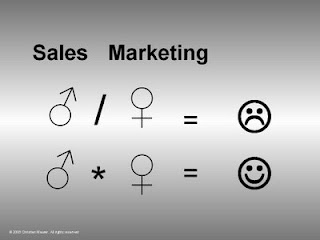
is the free translation of a public workshop I premiered last week with ZfU International Business School in Switzerland.
Delegates from various industries involved in B2B scenarios in either Marketing and/or Sales leadership functions discovered that they all had similar problems with their Sales and Marketing silos.
An assessment of each others function revealed that Marketing complained about Sales being too short term, tactical oriented, and not giving feedback from the field, whereas Sales complained about Marketing being too remote from reality, long term oriented and not listening to the field. The product versus the customer view was another divider.
However,in the following self assessment, the Marketing Leaders initially believed product orientation and the strategic view being key to their function. Sales Leaders admitted their short term view as a a necessity and believed their customer orientation being a crucial asset they provided to their company.
We then concluded that alignment between Marketing and Sales cannot mean making them think and act alike, but entering into a continuous dialog leveraging each others views.
Some companies had delegated both their Sales and their Marketing
executives to the seminar. It became clear that they had made attempts before to narrow the gap. However they lacked a framework for a structured discussion. Their talks did therefore not produce concrete results.
The inside out view induced by the product orientation revealed itself as major roadblock. The recommendation to use the context of the customer's buying process to discuss effective messages to the market and to agree on the split of responsibilities how to help the customer to buy, was therefore well received. Taking this view, sales leaders had to admit that there are buying scenarios where human interaction with sales people is no longer needed. On the other hand marketing leaders had to realize that the frequently observed attempt to reach further down into the sales funnel and handing over only hot qualified leads to sales is not as an ideal solution to bridge the gap between the two silos as suppliers of lead-generation, -nurturing and -scoring tools want us to believe.
Having an end to end framework to define Key Performance Indicators was welcomed as another tool helping to enhance the understanding for each other.
Marketing executives from Swisscom's , the incumbent Swiss telecoms operator's, Enterprise Division illustrated to the other delegates how their continuous customer centric dialog with sales had helped them to turn a product centric market approach into a customer centric problem solving approach. Marketing treating sales as a customer of their services, was another critical success factor for narrowing the divide between them and sales They are taking the idea of treating sales as a customer so far that a product manager is sent back to the drawing board if a campaign is considered 'not feasible for the field' by the sales people.
You can get a glimpse of Swisscom's customer centric problem solving approach on their web site for corporate customers.
Their filed sales people have a similar application loaded on their lab tops to insure consistency of the message to the market. Whereas traditional sale collaterals had not much success with the sales force, initial reaction from sales people about this new tool are very encouraging .

Its a great pleasure reading your post.Its full of information I am looking for and I love to post a comment that "The content of your post is awesome" Great work. Marketing System
ReplyDelete